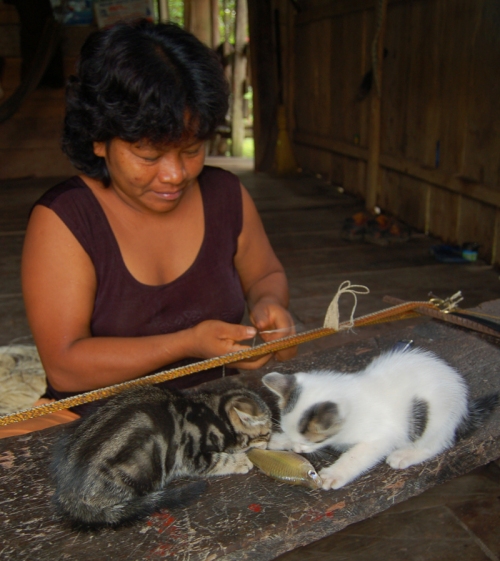
Ines lighting copal incense. Photo by Campbell Plowden/CACE
I first became aware of Ines during my second visit to the Bora native community of Brillo Nuevo in 2009 because she was enthusiastic about everything. When we first tried to make incense candles from copal resin, she immediately got her hands blackened with the burnt sticky stuff and suggested they might look nice in the half-shells of macambo fruit pods. She pulled me aside, though, and said, “You know these are really pretty ugly.” I said, “I know,” and she burst out laughing.

Graciela and Ines drawing snake patterns for belts. Photo by Campbell Plowden/CACE
Ines is a quintessential artisan from the Peruvian Amazon. She said, “I live by selling bags and hammocks made from chambira palm that I cultivate in my fields.” While meeting with artisans in a Brillo Nuevo classroom to discuss weaving new products to expand their income, Ines jumped at the chance to go the blackboard to draw the patches and wavy lines of a cascabel (tropical rattlesnake) as a design for a woven snake-pattern belt.

Ines weaving cascabel pattern belt with cats. Photo by Campbell Plowden/CACE
Ines soon welcomed me into her home while making the prototype on her hand-made loom with her two cats munching on a little fish in front. Ines’ voice stood out in the animated mélange of Spanish and Bora of artisans discussing their creations and her distinct laugh could mark her location more than a soccer field away.

Ines grating mishquipanga fruits to dye chambira fiber. Photos by Campbell Plowden/CACE
Over the past six years, we have shared many adventures, triumphs and challenges with Ines. She showed us how she grew, collected, and prepared half a dozen plants used to dye chambira palm fiber various shades of yellow, orange, red and deep purple and then dyed my silvery hair black with roasted leaves from a huito tree. She has proudly showed us new styles of bags and guitar strap designs that she invented and readily shared these with her fellow artisans in skill-sharing workshops.

Ines dyeing Campbell’s hair with huito leaf mash. Photo by Yully Rojas/CACE
Ines’ hard work made her the most prolific craft maker with CACE. She once told me, “I really like working with your project because it has given me a chance to create new kinds of crafts and improve the quality of my weaving. The extra income has allowed me to help my sons study at a better school.”

CACE volunteer Amrit and Ines with certificate. Photo by Campbell Plowden/CACE
Giving Ines an award for being the top-selling artisan in her community, though, first generated more resentment than accolades from her peers. One evening, she came to talk and began to cry. “My sisters and I love working with your project, but we are thinking of dropping out because people can be so mean.”
I soon met with other artisan leaders and families to hear their view of the situation. They had said they wanted us to give certificates to artisans according to their sales and give small prizes as incentives for doing extra good work. Did they want us to stop? We wouldn’t continue the practice if it was going to stimulate jealousy and weaken rather than build their community. One artisan Gisela said, “We really do like the certificates because they give us pride about our success. The prizes are good as well, but don’t ask us to select any winners.”

Casilda with chambira hot pad. Photo by Campbell Plowden/CACE
Since that meeting, some things have gotten better, and we have had to face new challenges. Over the past few years, providing some soda and snacks at the award ceremony, applauding and taking a picture with every winner has made this a fun and more mutually supportive event. When we announced that Ines was the top-seller again, one artisan Casilda said, “I knew that was coming, but it’s OK, I’m going to keep making more crafts myself.”
I’ve also learned that while Ines has a big heart, she can also be a tough cookie. During one recent artisan meeting, we were talking about ways to encourage artisans to plant more chambira palms when suddenly Ines and another artisan leader began yelling at each other. Apparently our survey of chambira in their fields had reignited an old dispute about whose family had the rights to harvest plants in one small section of recovering forest.

Artisans playing “crocodiles and frog” during meeting at Brillo Nuevo. Photo by Campbell Plowden/CACE
The incident helped me realize that artisans’ periodic troubles cooperating may be rooted more in historical frictions in the community than personality clashes in the present. We’ve been trying to bring people together in our project and navigate around hazards that appear like the tips of Amazon village icebergs. I’m glad that we have at least won the trust of talented and caring and sometimes feisty artisans like Ines to help guide us.


